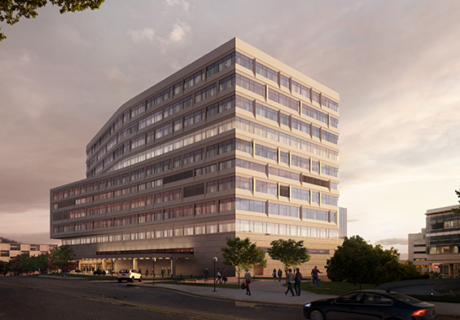Healthcare Design For The Ages
While assisted living and continuing care retirement community (CCRC) developers were going like gangbusters a few short years ago, the picture is quite different today. Granted, there’s still an estimated 77 million aging baby boomers. But a combination of the housing market crisis and “aging in place” trends has kept many boomers at home.
So it’s not surprising that facilities in this market today seem to be pulling out all the stops to create a more home-like feeling, to make aging boomers feel more comfortable in making the transition while also retaining a better sense of community. Says Joe Zody, senior living leader, DLR Group (Portland), “The goal is to make the transition from the elders’ current home to the [facility] seamless.”
Step inside
One trend that Mitchell S. Elliott, chief development officer, Vetter Health Services (Elkhorn, Neb.), sees as driving assisted living designs is smaller, more intimate living environments. Referencing his favorite book, Think Big, Act Small—penned by business management expert Jason Jennings—Elliot suggests that smaller living spaces, combined with decentralized staff work areas, enable the caregiving team to deliver higher quality, relationship-based care.
As for those all-important amenities, “Residents in senior living facilities are no longer content with the standard multipurpose room where they can play cards or attend holiday parties, or the standard dining room with marginal food and a rigid schedule,” says Sheila Bosch, director of research, Gresham Smith & Partners (Tampa, Fla.).
Instead, facilities’ central dining halls are being replaced by smaller dining areas designed as restaurants, and the former single exercise room with gym equipment has become a fitness and spa facility.
“Dining venues need to have the same ‘vibe and cool’ as neighboring restaurants, so living rooms situated at the entrance, for example, can be converted into sports bistros and/or coffee and breakfast bars, complete with a 60-inch plasma TV that invites the active and vibrant senior,” says Daniel J. Cinelli, principal and executive director, Perkins Eastman (Washington, D.C.).
The more trendy facilities are also incorporating display cooking, where seniors can enjoy watching their food be prepared, as well as gourmet take-out and fast food options.
“These bar/bistro areas are being more commonly designed where residents come to mingle and converse. Also, billiards/card/ice cream parlor rooms and other fun areas are beginning to surface more in our design,” says George M. Johnson, senior client manager, Smith Seckman Reid (Nashville).
As for entertainment, rooms with theater-style seating offer movie nights, lectures, and distance-learning opportunities with colleges and universities; art galleries feature different artists on a rotating basis; and events like wine and cheese parties up the ante.
“A general store where seniors can purchase everyday items is another popular amenity, and a growing number of senior care communities are offering on-site salon services, such as hair care, massage therapy, and even acupuncture,” Bosch adds. “Well-care clinics are being integrated in senior living facilities where a primary care physician and/or nurse practitioner and podiatrist can help residents monitor chronic conditions like diabetes.”
And the list goes on as senior living venues may be offering clubhouses, outdoor and indoor pools, cabanas, golf simulators, tennis courts, wine lockers, bars, bowling alleys, pickelball courts, walking trails, a wood shop, library, or an art/pottery room.
Dashing décor
With hospitality and residential interiors so well established in senior care environments, manufacturers across the board are beginning to meld their healthcare and hospitality product lines, observes Laurie E. Butler, an associate principal with Perkins Eastman (Pittsburgh).
“An expansion of material and fabric choices with inherit properties of chemical resistance continue to be introduced to the market every day,” agrees DLR’s Zody. “Granite counter tops, elevated appliances, wood trim, walk-in closets, ceiling fans, and individual temperature control are all aimed at minimizing the impact of the transition for residents and families.”
In a similar vein, decorative lighting is not only being used in common areas, but in the resident rooms, as well. And while higher-end wall and floor coverings were previously a popular choice, Johnson is seeing a return of traditional paint and wall accessories to create a more realistic, homelike environment.
“We all grow tired of big bold prints and lots of color that we find in our hospitality-oriented environments, and I’m a bit concerned that the eyes of 20- and 30-somethings are determining the trendy styles that we may be trying to incorporate into our senior environments,” Elliot says. “As a 50-something, I personally love the deep, rich colors that we find in today’s environments. The earth tones found in the dark browns and dark greens can be soothing and comforting–but brown turns black to an older eye. The reality is, it’s not about what I like. It’s what they like.”
Going deeper
Fortunately, there’s a slowly growing body of environmental design research and post-occupancy evaluations (POE) being conducted by architectural firms to determine these preferences and needs. For example, rocking chairs have been linked to improvements in depression and anxiety, as well as lower use of pain medication.
As part of Perkins Eastman’s Research Collaborative, architects have led a number of POEs at long-term care facilities, offering insights to confirm anecdotal design principles and debunk a number of myths, explains J. David Hoglund, principal, executive director, Perkins Eastman (Pittsburgh).
In fact, one wayfinding study discovered that color and pattern were totally ineffective orientation tools for residents to find their rooms without the aid of distinctly shaped or positioned furnishings and visual landmarks.
“We then took what we learned and made the residences distinct in their interior design, from trim and lighting to furnishing styles and landmark features at the entrance, when we designed the Copper Ridge CCRC in Sykesville, Md.,” Hoglund says.
The firm also learned from that project that visual connection to familiar faces is important, too.
“For the design of Asbury Place, a senior living community in Pittsburgh, we incorporated all of these ideas, but also created an interior bay window near the entrance so that residents could see their familiar staff in the kitchen,” says Hoglund.
Meanwhile, Gresham Smith & Partners (GS&P) has also conducted environmental design research, including a recent study in conjunction with the Georgia Institute of Technology and Florida Presbyterian Homes. This particular effort evaluated the optimal space required for assisted transfers onto and off of the toilet.
”Analysis of the observation data revealed no significant differences among the four configurations for transfer mechanics, and the amount of physical assistance provided,” says Bosch. “Similarly, there were no significant diff
erences among the configurations in the amount of assistance provided.”
Technology today
Another significant aspect of senior facility designs is the implementation of the latest technology, from wireless Internet to resident monitoring systems.
“Fifteen to 20 years ago it was difficult to find even a computer room with three or four out-of-date computers relegated to the lower level,” Zody says. “Now it’s expected that every resident apartment has multiple connectivity points and all of the common areas in the facility are available for wireless connectivity.”
As for resident care, electronic medical records are improving operational efficiencies, and more sophisticated monitoring and paging systems are enabling the decentralization of the care-giving staff as well as promoting a quieter, less intrusive environment.
Staying strong
Despite the changing industry, the senior living market, for designers, remains an exciting and interesting niche.
“Communities for the aging adult have probably never been better than they are today, but perhaps one of the biggest challenges these facilities face is offering desired amenities while keeping prices affordable for those on fixed incomes,” Bosch says.
Barbara Horwitz-Bennett is a contributing editor for Healthcare Design. She can be reached at bbennett@bezeqint.net.



